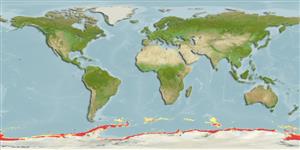Hexactinellida |
Lyssacinosida |
Rossellidae
Environment: milieu / climate zone / εύρος βάθους / distribution range
Οικολογία
; εύρος βάθους 18 - 2000 m (Αναφ. 89939). Polar
Antarctic.
Length at first maturity / Μέγεθος / Weight / Age
Γεννητική Ωρίμανση: Lm ? range ? - ? cm
Color: white, yellow, or orange. Growth form: varies from large to barrel or vase shaped for adults around 50 cm high; or vase or egg shaped for budding types up to 15 cm high (Ref. 089939).
Deposits spicules on soft substrates, eventually forming hard mats that is important in colonization. Suspension feeder. Photosynthetic diatoms are present within its cells, but role is still unclear. Reproduction is both sexual and asexual (Ref. 089939).
Life cycle and mating behavior
Γεννητική Ωρίμανση | Αναπαραγωγή | Γεννοβολία | Eggs | Γονιμότητα | Larvae
Members of the class Hexactinellida are hermaphroditic. Life cycle: The zygote develops into trichimella larva (free-swimming) before settling down on a substrate where it grows into a young sponge.
Andrew, N. and M. Francis 2003 The living reef. The ecology of New Zealand's rocky reefs. Craig Potton Publishing, New Zealand. 283pp. (Αναφ. 82739)
IUCN Red List Status
(Αναφ. 130435: Version 2025-1)
CITES status (Αναφ. 108899)
Not Evaluated
Not Evaluated
Threat to humans
Harmless
Human uses
| FishSource |
Εργαλεία
Περισσότερες πληροφορίες
Τροφική ΟικολογίαFood items (preys)Σύσταση δίαιταςΚατανάλωση τροφήςΘηρευτές Population dynamicsΑύξησηMax. ages / sizesLength-weight rel.Length-length rel.Length-frequenciesMass conversionΑφθονία Life cycleΑναπαραγωγήΓεννητική ΩρίμανσηΓονιμότηταΓεννοβολίαEggsEgg developmentLarvae PhysiologyΚατανάλωση οξυγόνου
Human RelatedStamps, coins, misc.
Διαδικτυακές πηγές
Estimates based on models
Preferred temperature
(Ref.
115969): -1.9 - 1.4, mean -0.6 (based on 1968 cells).
